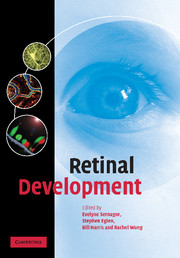Book contents
- Frontmatter
- Contents
- List of contributors
- Foreword
- Preface
- Acknowledgements
- 1 Introduction – from eye field to eyesight
- 2 Formation of the eye field
- 3 Retinal neurogenesis
- 4 Cell migration
- 5 Cell determination
- 6 Neurotransmitters and neurotrophins
- 7 Comparison of development of the primate fovea centralis with peripheral retina
- 8 Optic nerve formation
- 9 Glial cells in the developing retina
- 10 Retinal mosaics
- 11 Programmed cell death
- 12 Dendritic growth
- 13 Synaptogenesis and early neural activity
- 14 Emergence of light responses
- New perspectives
- Index
- Plate section
- References
3 - Retinal neurogenesis
Published online by Cambridge University Press: 22 August 2009
- Frontmatter
- Contents
- List of contributors
- Foreword
- Preface
- Acknowledgements
- 1 Introduction – from eye field to eyesight
- 2 Formation of the eye field
- 3 Retinal neurogenesis
- 4 Cell migration
- 5 Cell determination
- 6 Neurotransmitters and neurotrophins
- 7 Comparison of development of the primate fovea centralis with peripheral retina
- 8 Optic nerve formation
- 9 Glial cells in the developing retina
- 10 Retinal mosaics
- 11 Programmed cell death
- 12 Dendritic growth
- 13 Synaptogenesis and early neural activity
- 14 Emergence of light responses
- New perspectives
- Index
- Plate section
- References
Summary
Introduction
In the past half-century the field of biology has witnessed a burgeoning of understanding of the biochemistry, molecular and cell biology of cell signalling. More recently, a significant effort was made to focus the techniques and concepts of biology to a mechanistic understanding of the nervous system. Within the area of development, perhaps the cardinal question has been how to signal immature cells to form the diverse organs, tissues and differentiated cells of the body – a particularly challenging question in the nervous system given the great diversity of cell types to be made. Because of its combination of diverse cell types within a highly structured tissue the vertebrate retina has served as an important model tissue in pursuit of answers to such questions. Specifically, the retina displays a laminar cytoarchitecture, and seven cell types that are largely confined to one of three laminae. These include receptors (rod and cone photoreceptors), short and long projection neurons (bipolar and retinal ganglion cells, respectively), local circuit neurons (horizontal and amacrine cells) and glia (Müller cells). The constancy of retinal structure and cell types across vertebrates allows cross-species comparisons to be readily made. Further, almost all retinal cell types exhibit multiple levels of differentiation. For example, there are several subtypes of ganglion cells or amacrine cells based on morphology, transmitter content, synaptic connectivity, etc. Thus, explanation of determination and differentiation can be sought at multiple levels of specificity.
- Type
- Chapter
- Information
- Retinal Development , pp. 30 - 58Publisher: Cambridge University PressPrint publication year: 2006
References
- 10
- Cited by



